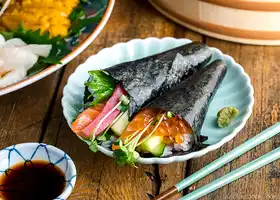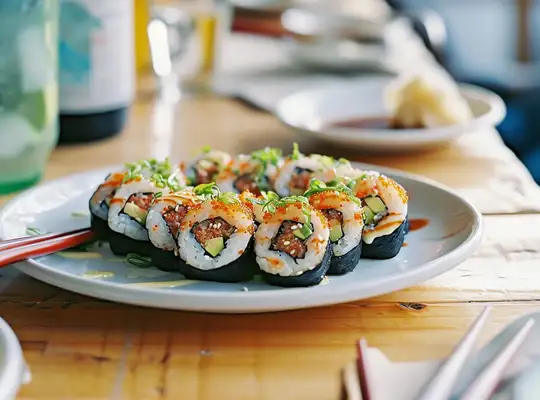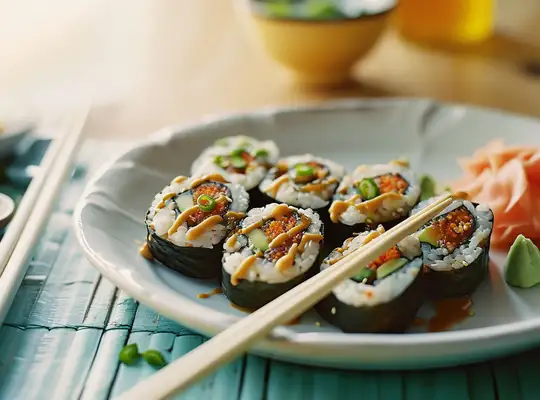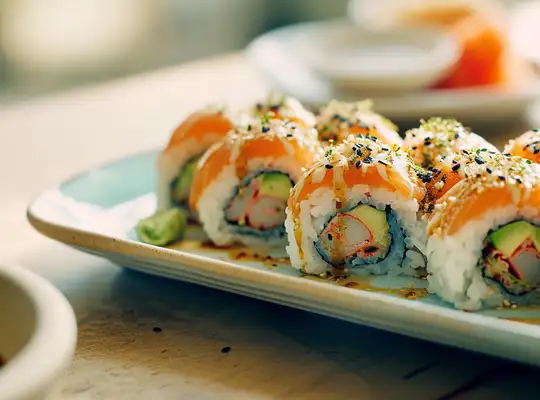
Tuna and avocado inside-out maki (uramaki)
delicious. magazineTry a taste of Japan with this deliciously healthy, low-fat dish of tuna and avocado inside-out maki.
- Dairy-Free
Download Stashcook Now. Get the best meal planning app for your family.

Dive into making your own sushi! It's a fun kitchen adventure where you wrap up rice and your chosen goodies in seaweed. Roll it tight, slice it up, and wow everyone with bite-sized delights. Perfect for a family activity or impressing friends with homemade sushi night!
Discover 105 unique Sushi recipes. Each with it's own twist on the recipe.

Try a taste of Japan with this deliciously healthy, low-fat dish of tuna and avocado inside-out maki.

Cook Sushi in the comfort of your home with BetterButter. Tap to view the recipe!

Make sushi at home with simple hand rolled sushi called Temaki Sushi. Everyone in the family (or at the party) will have fun rolling the nori sheets around sushi rice and their favorite fillings!

Using quinoa instead of rice means these rolls are higher in protein. We've kept them vegan too, no fish means leftovers will keep for a healthy lunchbox the next day

This Japanese inspired recipe for vegetarian sushi squares makes an easy and sophisticated canapé.

Recipes that can be made in less than 30 minutes.

Quick and easy recipes you can make in under 15 minutes.

Recipes without meat, fish, or poultry, may include dairy and eggs.

Recipes suitable for vegetarians who consume both eggs and dairy.

Vegetarian recipes that include dairy but no eggs.

Recipes free of gluten, suitable for those with gluten intolerance or celiac disease.

Vegetarian recipes that include eggs but no dairy.
The best type of rice for making sushi is a variety called short-grain Japanese rice or sushi rice. This type of rice has the perfect balance of high starch content and moisture absorption, which allows it to stick together when cooked, making it ideal for forming sushi rolls or nigiri.
When preparing sushi, you should look for brands that specifically label their product as "sushi rice." Some popular varieties include:
These types of rice become sticky when cooked, which is essential for sushi since it needs to hold its shape without falling apart. It's also important to rinse the rice thoroughly before cooking to remove excess starch and achieve the right texture.
Here's a basic outline on how to prepare sushi rice:
Remember that proper seasoning and cooling are just as important as choosing the right type of rice when making authentic-tasting sushi at home.
To make the rice sticky enough for sushi, you need to follow a specific process when cooking and seasoning the rice. Here's a step-by-step guide using markdown syntax for emphasis:
rice vinegar, sugar, and salt. The typical ratio is about 5 tablespoons of vinegar, 2 tablespoons of sugar, and 2 teaspoons of salt for every cup of uncooked rice. By following these steps carefully, you'll have perfectly sticky sushi-grade-rice ready for making delicious homemade sushi! Remember not over-stirring as that can make the grains mushy rather than keeping their individual integrity intact which is essential in good quality Sushi Rice preparation!
No, you do not need a bamboo mat to make sushi rolls, although it is a traditional tool that can help in rolling tight and even sushi. However, if you don't have one, there are alternative methods you can use:
Remember that making good sushi rolls requires practice, so don't be discouraged if your first few attempts aren't perfect!
Yes, you can use raw fish in your homemade sushi, but it's important to ensure that the fish is fresh and safe to consume raw. Here are some key points to consider when using raw fish for sushi:
Remember that consuming raw seafood carries an inherent risk of foodborne illness regardless of precautions taken; individuals with compromised immune systems should avoid eating uncooked seafood altogether.
Rolling sushi can be a delicate process, but with the right technique and some practice, you can create rolls that hold together well. Here's a step-by-step guide on how to properly roll sushi:
By following these steps carefully and practicing regularly, you'll be able to produce well-formed sushi rolls that won't fall apart when sliced or picked up with chopsticks!
Certainly! Here's an explanation of the difference between nigiri and maki sushi, with markdown syntax for highlighting:
In summary:
For making sushi rolls, you should use nori seaweed. Nori is a type of edible seaweed that comes in thin, dried sheets. It's specifically used for wrapping around the rice and filling to form sushi rolls, also known as maki. When purchasing nori for sushi-making, look for sheets that are dark green to black in color and have a uniform texture without any holes or tears.
Here's how you can prepare your sushi rolls using nori:
Remember that there are different grades and qualities of nori; if possible, opt for high-quality "sushi-grade" nori as it tends to be more flavorful and less prone to tearing when rolled.
Enjoy making your sushi!
To make sushi rice vinegar, you will need the following ingredients:
Yes, you can use quinoa instead of rice for making sushi. Quinoa is a nutritious seed that has gained popularity as a healthy alternative to traditional sushi rice due to its high protein content and rich nutrient profile.
Remember that while using quinoa can be delicious and healthy, its texture differs from traditional sticky sushi rice—it's less sticky so rolls may not hold together quite as firmly as they do with rice—but many people enjoy this variation on classic sushi nonetheless!
Seamlessly add your favorite Sushi recipes to your personal digital cookbook.
But that's just the start! Add recipes from cookbooks and magazines too. Stashcook's AI technology extracts recipes right off the page with just one click.
With Stashcook, organize all your recipes in one convenient place and master meal planning like a pro. Join the thousands already making meal planning simpler and more enjoyable.
Download Stashcook for FREE today and begin your journey to effortless meal planning.
Email:
hello@stashcook.com© Copyright 2024 Stashbox Ltd. All rights reserved.